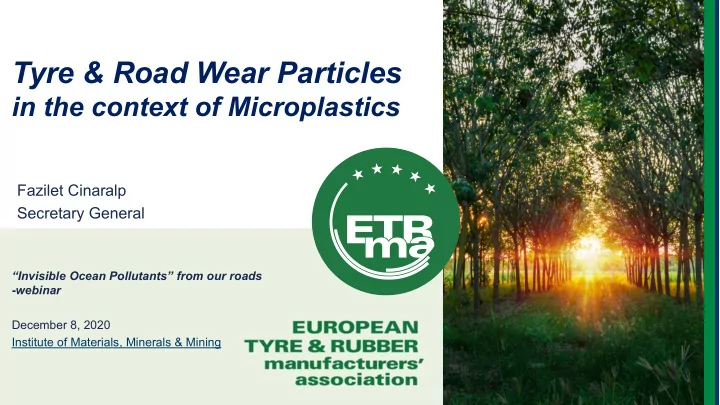

1 ETRMA Tyre & Road Wear Particles in the context of Microplastics Fazilet Cinaralp Secretary General “Invisible Ocean Pollutants” from our roads -webinar December 8, 2020 Institute of Materials, Minerals & Mining
2 Tyre and Road Wear Particles A complex sustainability challenge The challenge: The friction between tyre and road (=grip) is essential to ensure road safety ; TRWPs are tiny debris which are formed from the friction between the tyre and the road, and consist of an agglomeration of approximately 50% weight by weight (w/w) of tyre tread and 50% road pavement materials Reducing TRWP is complex. TRWP levels do not depend exclusively on tyre characteristics and condition, but are affected by several external factors: driving behaviour, road characteristics (surface and topology), vehicle characteristics, This is why a holistic and multi-sectorial approach weather conditions. is needed!
4 Tyre and Road Wear Particles Building knowledge (1/2) 2017 2005- 2020… • ETRMA-commissioned • The Tire Industry Project has study analysed the distribution been supporting research into and retention of tyre and road tire and road wear particles wear particles in freshwater since 2005 and transportation to saltwater environments. • 15 years of TIP research knowledge is publicly available • Main conclusion shows that at this link. 2-5% of particles generated on roads are estimated to arrive • TIP’s research to date has at the end of river streams found that the presence of which flow into the open TRWP presents no significant waters of seas and oceans. risk to humans or the environment. • Characterizing export of land-based microplastics to the estuary - Part I: Application of integrated geospatial microplastic transport models to assess tire and road wear particles in the Seine watershed. (2018) • Characterizing export of land-based microplastics to the estuary – Part II: Sensitivity analysis of an integrated geospatial microplastic transport modelling assessment of tire and road wear particles. (2018)
4 Tyre and Road Wear Particles Building knowledge (2/2) Tyre Industry, through TIP and regional tyre associations, continues to study • the potential impact to long-term exposure to TRWP, • the degradation of TRWP in the environment, and • the presence, fate and transport of TRWP in air, soil, rivers and oceans
Tyre and Road Wear Particles Mitigation Measures (1/2) Tyre design – Since 2018 Intensive industry resources to advance on a feasible and robust abrasion test method to minimize tyre abrasion, that could be used for regulatory purposes to represent European market needs, conditions and targets, as well as new technologies to minimize trade-offs, mainly for wet traction.
Tyre and Road Wear Particles Mitigation Measures (2/2) A multistakeholder approach – Since 2018 The Platform – facilitated by CSR Europe- aims at creating an open and inclusive dialogue among all relevant stakeholders to explore a balanced and holistic approach to address and better understand Tyre and Road Wear Particles. 1. Share state-of-the art scientific knowledge ; 2. Achieve a common understanding of the possible effects of particles generated during normal tyre use and wear; 3. Identify the greatest potential for curbing TRWP , and co-design mitigation options .
Participants of the Platform
The outcomes of the 1 st year of activities (2018-2019) After its first year of activities, two reports published: The “ Scientific Report on TRWP in the Aquatic The “ Way Forward Report ” explores the Environment ” by Prof. Dr Martin Jekel from TU Berlin: most promising ways of mitigating the environmental impact of TRWP through Knowledge gaps identified include a.o. potential actions of stakeholders across • Need for a reliable and representative tyre abrasion the entire value chain, including: test • measures to minimize TRWP • Influence of road parameters on TRWP generation generation; • Quantitative analytical tools for TRWP • measures to address TRWP capture • Degradation in soils and sediments (acting as and removal ; sinks) • pathways for continued cross-sector • Capture systems for TRWP in run-off and sewer collaboration. overflow • Improved and validated mass balance models • Ecological effects of TRWP
Measures identified that can be implemented in the short term TRWP Minimization
Measures under implementation… • ETRMA commitment to TRWP Platform to become permanent platform • Work on methodologies • Tyre abrasion rate is the appropriate indicator to address TRWP mitigation. Tyre Industry is working towards a harmonised, representative and discriminatory test method that could be used for regulatory purposes • Work on knowledge gaps : • through H2020/Horizon Europe: • Sept2020 – Project submitted by Consortium under TU Berlin coordination [ETRMA +10 other Partners] Abrasion test definition (led by tyre industry) and Mitigation measures for TRWP definition and assessment • Future research e.g. Electrification impact … • WBCSD-Tire Industry Project continued Study plan • Create incentives & awareness raising campaigns towards positive driving behaviour • Identify hotspots to facilitate the launch of regional pilots
11 CONCLUSION 1) The Tyre Industry recognises the need to address TRWP and sustains its action plan with strong attention and efforts; 2) Significant knowledge gaps remain: we aim to address them, and at the same time we call for a proportionate approach to TRWP in the entire microplastics debate; 3) Comprehensive and balanced approach is essential for effectively tackling TRWP, considering other key tyre requirements; 4) Solutions can be comprehensive and effective only when involving proportionately all stakeholders relevant for the TRWP generation and mitigation; 5) The EU tyre sector remains open for further dialogue and cooperation with the legislator and other relevant stakeholders
12 ETRMA Thank you Any Questions? Fazilet Cinaralp
Recommend
More recommend